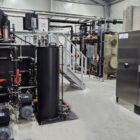Ammonia stripping is a physico-chemical process for removing ammonium (NH₄⁺) or ammonia (NH₃) from wastewater. This process is frequently used in industrial wastewater treatment to reduce high nitrogen concentrations and thus comply with the legal limits for the discharge of wastewater into water bodies. The process is based on converting the ammonium dissolved in the wastewater into gaseous ammonia and then expelling it from the water flow.
Table of contents
Technical background
In aqueous solutions, nitrogen is present as an ammonium ion (NH₄⁺) or as ammonia (NH₃), depending on the pH value and the temperature of the water. At a low pH value, nitrogen is predominantly present as an ammonium ion, which remains dissolved in the water. If the pH rises, the balance shifts in favor of ammonia, which can be removed from the solution as a gas. Ammonia stripping makes use of this chemical relationship to remove the nitrogen from the water in the form of gaseous ammonia.
Stripping is carried out in several steps:
pH adjustment: In order to convert the ammonium ions into gaseous ammonia, the pH value of the wastewater is increased to around 10 to 11, usually by adding alkaline solutions (e.g. sodium hydroxide or calcium hydroxide). In this highly alkaline range, most of the nitrogen is present as ammonia.
Heating: The wastewater is often additionally heated to a temperature of 25-50°C in order to reduce the solubility of ammonia in the water and increase the efficiency of the stripping process.
Gas expulsion (stripping): Air is passed through the treated wastewater in a stripping tower or gas scrubber. Air (or sometimes steam) is blown through the water, which transfers the ammonia into the gas phase. These gas bubbles transport the ammonia out of the aqueous phase.
Ammonia scrubbing: The expelled ammonia is collected in the exhaust gas flow and neutralized in a downstream gas scrubber. For this purpose, the ammonia is often absorbed in an acid solution (e.g. sulphuric acid) and bound in the form of ammonium sulphate, which can be reused as fertilizer.
Advantages of ammonia stripping
- High efficiency: Ammonia stripping can remove large quantities of ammonium from wastewater, especially in the case of wastewater with high nitrogen concentrations.
- Recycling of ammonia: The expelled ammonia can be bound in a downstream process, such as ammonia scrubbing, and reused as ammonium sulphate, for example as a fertilizer in agriculture.
- Avoidance of nitrogen inputs: The reduction of nitrogen in wastewater helps to reduce the eutrophication of water bodies and helps to comply with legal limits.
Challenges and disadvantages
High pH value and chemical consumption: The conversion of ammonium to ammonia requires large quantities of alkaline solutions to raise the pH value of the wastewater. This can lead to increased operating costs and requires subsequent neutralization of the wastewater.
Energy consumption: As the wastewater often has to be heated, ammonia stripping is relatively energy-intensive, especially with very large quantities of wastewater.
Waste gas treatment: The expelled ammonia must be collected and treated in the gas phase, which requires additional plant technology to prevent the release of ammonia into the atmosphere.
Conclusion
Ammonia stripping is a proven method for the efficient removal of ammonium and nitrogen from industrial wastewater, especially in wastewater with a high nitrogen load. By converting ammonium into gaseous ammonia and then expelling it, nitrogen loads can be effectively reduced. However, the process requires careful pH adjustment, a high energy input and comprehensive waste gas treatment in order to fully exploit the benefits of ammonia stripping.








